IN A STRANGE TOWN.
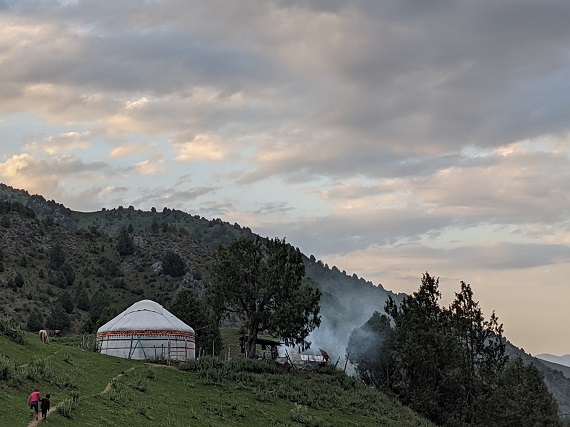
Chapter 3. August 8, 2021. Text by Kevin/SC. # Comments
Great Grandma Amar arrived with her family at the summer camp in May. A long winter of snow had melted, covering the meadow and steep hills with grass and wildflowers. It took five people a full afternoon to build the yurt and cover it with cloth and sheepskins. The horses, many with foals in tow, were now grazing in the shade, relieved to have finished the journey from their village. One other yurt stood further down the creek, past the small field of wheat. It is July, which for Kyrgyz villagers means it is the season of the jailoo, the summer pasture.
We stepped into Amar’s yurt. Small carpets and cushions were spread on top of felt, pileless kilim rugs. A hole in the ceiling, a convertible whose cloth flap was controlled by ropes on either side of the house, let in the sun. Amar was rolling dough into thin layers to be cooked in a qazan, a large metal cauldron, making manti dumplings for dinner and mailama, a delicious wild onion lavash we ate while still hot to the touch, as an afternoon snack. An infant napped in the corner, while a young boy churned horse milk in a large goatskin sack set against the wall.
With fermentation, this becomes kymis, drunk all day by villagers in Central Asia and a notorious acquired taste for visitors. In the cities of Kyrgyzstan, women in red aprons sit under umbrellas hawking Shoro - literally “salty” - a series of fermented wheat and animal fat drinks. The brave foreigner in Bishkek who orders a cup of Shoro “aralash” receives plaudits. In the countryside, refusing kymis just brings confusion as to why such a delicacy would be rejected. We asked a driver why Kyrgyz people like these fermented drinks. His answer: “Because it’s our national beverage.” He filled a soda bottle with more kymis to bring home to his family in Osh, the regional capital.
Enjoying kymis because it is the Kyrgyz drink - the same sentiment explains why the jailoo is so important to people in this small republic in the heart of Asia. Bringing herds of livestock not just to where grass is abundant, but to the mountains, is the key. These mountains hide pastures in the knots of the Pamir, the Alay, the Hindu Kush, the Karakorum, forming places of respite from summer heat, from dusty valleys, from the Genghis Khans and Tamerlanes, the Bolsheviks, the Chinese Armies, the British Colonials and the Kashgaris, the Gokturks and Sogdians who mauraded through the region on their way to Delhi, Chang’an and Baghdad. In summer, the high valleys, with their sounds, smells, tastes, and traditions, are an essential part of the Kyrgyz national memory. You visit the summer pasture not just for practical reasons, but because the time there is part of what makes you Kyrgyz. To see why, we joined our guides Kubat Beg and Iskander on a five day march across four jailoos and one ominous 11,600 foot pass.
2. Family
“I Aiperi! Your name?”Our hostess Aiperi beamed, surprising us with her English, as she quickly laid the table for afternoon chai. Suddenly the extra trouble of climbing back up a hill to get to her yurt after spending two hours climbing down into the valley, melted away.
Aiperi made us feel like a cross between her favourite cousins and minor royalty had just arrived in her guest yurt, as she set a tablecloth on the ground and covered it with fresh naan, biscuits, wrapped bonbons, kaimak cream, honey, raspberry jam, melon, sliced cucumber and tomatoes, and, of course, tea. Everything was made from scratch, by the family, except for the inexplicable tea biscuits and wrapped bonbons, which seemed almost as omnipresent as the naan. Everything was delicious. Having hosted hikers in her guest yurt for 12 years now, she knew better than to offer kymis to the foreigners if they didn’t ask for it.
Aiperi informed us that she was 36 years old and proudly proclaimed that she had five daughters. Her presence was a whirlwind of enthusiasm and energy, which no doubt served her well during her non-stop days on the jailoo.
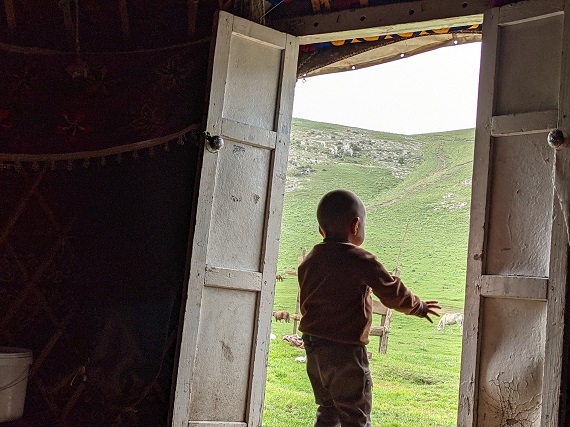
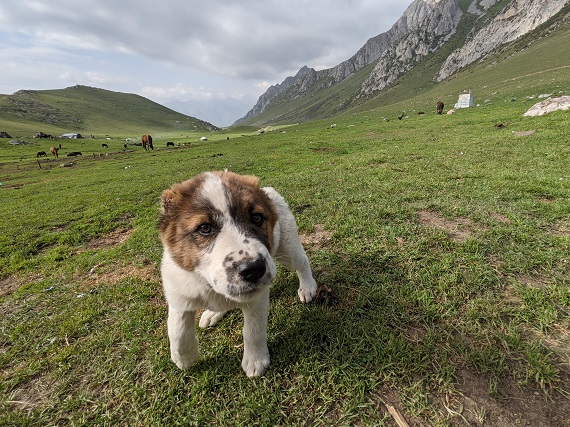
Life on the summer pasture is hard work for everyone involved: the cows and horses need to be milked, the milk needs to be turned into other goods that can be eaten or sold (butter, cream, kymis), all the food is cooked from scratch, animals (cattle, horses, chickens, turkeys, donkeys, dogs) need to be cared for. Cleaning needs to happen as well, and there is no running water or electricity to facilitate the task. While the jailoos and the few individual houses we saw are near a water source, either a river or a spring, it remains at minimum a short walk to get the water and haul it back to the yurt. And of course with all the animals roaming in the area, water needs to be boiled to be used safely in cooking or drinking.
For the most part, Aiperi and moms like her are running things by themselves. Their husbands are busy working hard in the villages, cutting and preparing winter feed for their animals. From the age of ten, boys join their fathers in their summer work. Before that, they stay with their mothers.
One aspect of life on the jailoo that seemed like less work than it is in Western countries was parenting. Even with the language barrier, it was clear that kids are a tremendous source of pride and joy. But from a very young age, they are also actively contributing members of the household: taking away and washing dishes, bringing the animals closer to the yurt at night, separating the cream from the milk after dark, running to get jugs of water from the spring.
While we quickly learned the word “Apa” (mom), because it was a common call from little mouths, Mom was getting a big hand from older siblings. On the whole, it appeared to be a much more laid-back approach to parenting. Perhaps this is what the “free range” parenting found in liberal Western cities aspires to be, though going further than they could tolerate. We saw an eight-year-old decide to give a two year old a donkey ride, which could have ended in an unfortunate fall. A startled horse or annoyed donkey could easily trample or kick a little person nearby. When the children went wild with a sugar rush, they were left to calm down by themselves. We saw two different two-year-olds put themselves down for a nap. When someone noticed, they placed a blanket over them to keep them warm. A novel contrast to the battles some parents wage at nap time!

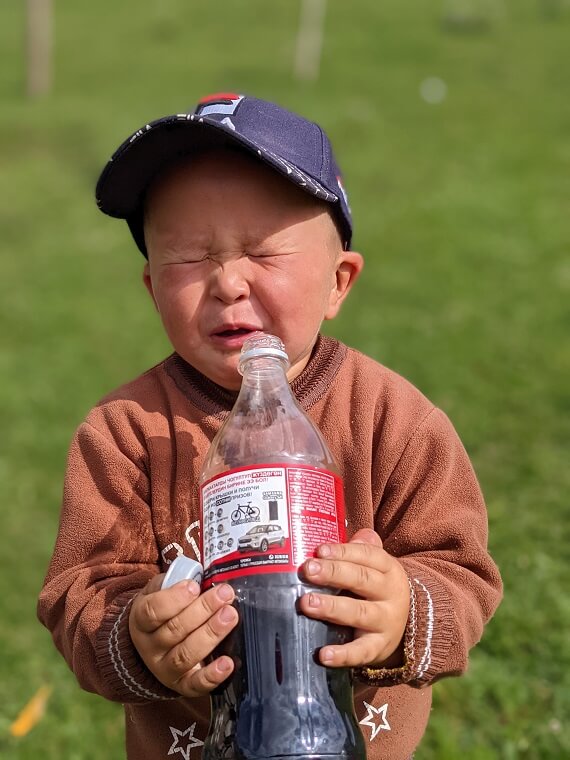
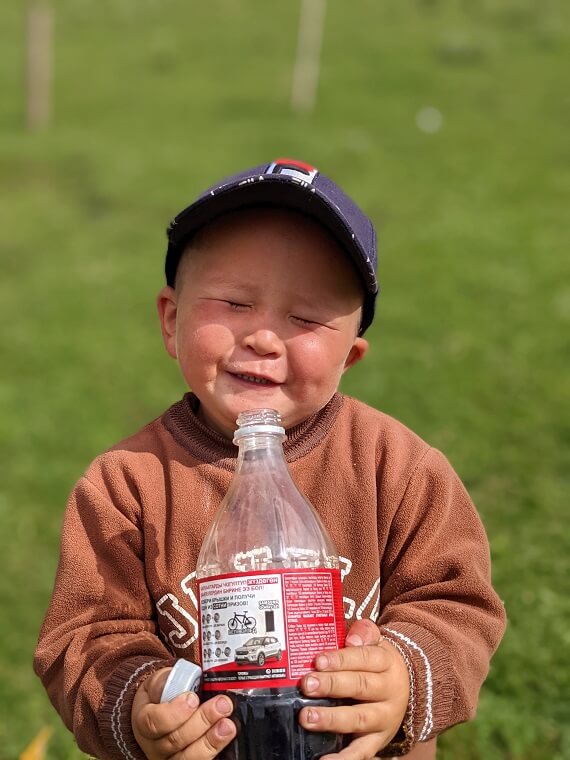
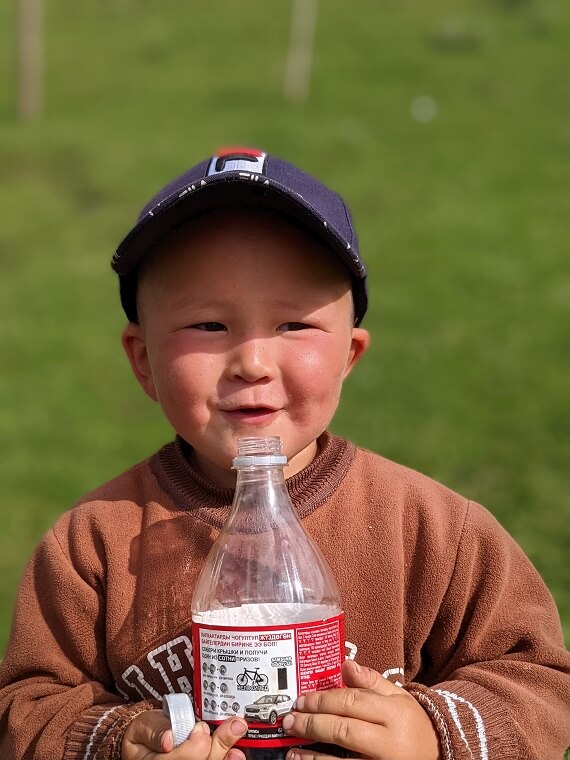
Perhaps more importantly, the children we met were on the whole delightful, some variation on friendly, curious, shy, polite, helpful, playful, kind, and chatty. It is easy to idealise rural life and not see the challenges when only passing through. But certainly some of the biggest drawbacks that can be deeply problematic in other rural settings did not apply here: access to health and education. Because life on the jailoo is only for a few summer months, kids are able to go to school in the village where they live during the rest of the year (school is publicly funded until 18 and even post-secondary education is covered by the government given a very high score on the national exam). Women don’t need to face the great risks that come with childbirth in their yurts, but rather in the regional hospital, which is accessible to them. So the screen-free, free range, busy, full life of the jailoo seemed as conducive to raising healthy children as healthy calves and foals.
3. The High Passes of the Alay
Kyrgyzstan is a high country, part of the “Roof of the World” wrapping around China’s Southwestern border. This region contains the world’s highest mountains, including the 23,406-foot tall Lenin Peak a few dozen miles from our hike. Southern Kyrgyzstan, in particular, is a land of peaks: the Alay and Pamir mountains soar out of the restless Ferghana Valley. Their high passes formed a notorious stretch of the Silk Road, challenging those who had escaped the slave raids of the Turcomen coming East or the vast emptiness of the Taklamakan desert if heading in the other direction. The great Silk Road cultures, the Arabs and the Chinese, fought their only serious battle at Talas, Kyrgyzstan in 751, the result of which was that the secret of making paper from the strong fiber of the mulberry tree was coerced from Chinese prisoners.Unsurprisingly, it was also one of the last unmapped places in Eurasia. As the Russian Tsar grew his borders across Siberia and Central Asia, and British India swallowed up vassal states in Sind and Punjab and Afghanistan, the two empires were separated by only a few hundred miles. The British worried that a secret attack route to India might exist, allowing the Russians to avoid the well-defended Khyber and Bolan passes, both known since antiquity. The Russians worried that British spies, disguised as dervishes, horse traders, or itinerant holy men, were secretly making deals with the notorious khans of Central Asia. Understanding the geography of this area - where pastures could be found, where water was abundant, where mountain ranges could be traversed - was therefore at the heart of the spy novel adventures of what Kipling would later call, in his novel Kim, The Great Game.
There are no more worlds to conquer, nor valleys to map for the first time, but the physical challenge and geographic oddities of this region have not lessened. We joked with Kubat Beg each day that he must like a morning challenge as we inevitably zigzagged our way up a steep mountain. Red marmots shouted warnings to their friends when they spotted us, running across the ridgeline into their condominiums carved into the mountainside. Black sheep, cattle, and horses forged their own paths toward higher grasslands. Many spend the entire summer on their own before hermit shepherds are contracted to find them before the late August wolves become hungry.
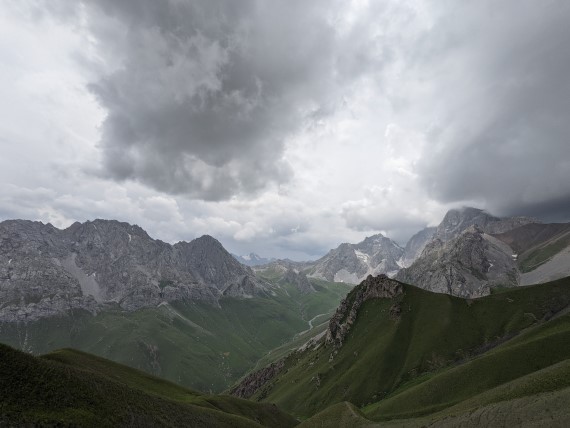

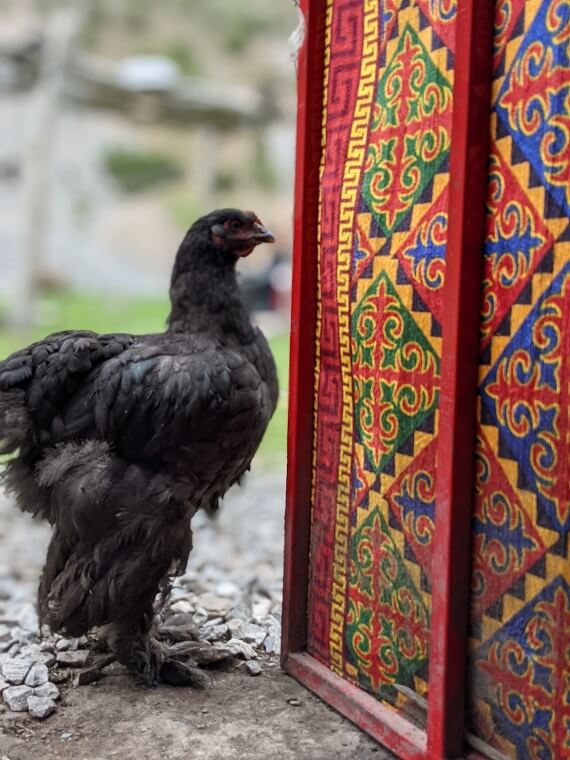
Our nights began at 8,000 feet, reaching 10,000 on the third day, a height you begin to feel in your lungs. The map gives away the details of a day’s hike. “Ala” - this word means striped black and white, suggesting the mountain you are approaching will be striated rock. “Tash” - stone - tells you your route will need to circumscribe near-vertical rocky cliffs common in the Alay. Though the climbs are often steep, it is the impermanent features of the hike that are the most troubling: weeds six feet tall, with thistles, stinging nettles, and thorns hidden in the underbrush. Each day took on a routine: the morning climb to a minor pass, an occasional horseman passing on the same route, and a downward scramble into the next valley.
Ak Tor Pass on the third day proved more challenging. Separating the Sary Oi and Murdash rivers, utterly impassable stone cliffs separate into a glacier, a scree field, and a narrow ridge. We camped below the pass, grateful for Russian down sleeping bags as the temperature turned brisk. This end of the valley was uninhabited, aside from livestock. Late at night, we heard a strange sound brushing against the side of the tent. I unzipped the tent and saw a cow’s black tongue licking the translucent rain fly. “Ah yes,” said Kubat Beg the next morning, “they always do that”. The jailoo belongs to the cattle as much as to the Kyrgyz.
The trees and grass were gone as we approached Ak Tor Pass the next morning, a herd of dozens of black yak the only other thing on the march. There was no time to celebrate reaching the peak, however: pitch black clouds were crawling over the nearest mountain. Just as we passed over the col, surround-sound thunder echoed. We jogged along a few hundred yards of open ridgeline, the sky darkening by the moment. As we reached the old nomad path heading down the other side of the mountain, a cold rain began to fall. It was time to leave the peaks and return to the smiles of the jailoo.
4. A Rare Visitor
Tired from a long day of hiking that involved some positively goat-like maneuvers on our part, and a half-hour away from our campsite, we passed two homes across a small river. These were the first people we had seen for many kilometers. Two very young boys ran down from one of the homes perched halfway up the hill. Their parents had sent them to invite us for chai. How could we say no to such an unexpected invitation?I would have found them to be quite friendly had they simply waved hello at a distance to the four strangers hiking by. We could not possibly have anticipated the red carpet treatment we were about to receive.
As we arrived at the homestead, cushions were being set down, fresh naan was laid out, and tea, already ready, was being poured. That was just the start. The wife went on to serve multiple small bowls of kaimak, sary muy (a kind of thick liquid butter), and chovogo. The latter was described to us as fried butter, which had a kind of mealy texture and a sweet, flavorful taste. It was as if they were expecting us, which of course was impossible. This summer, visitors passed by as seldom as every fortnight, with the exception of hunters illegally chasing wild goats.
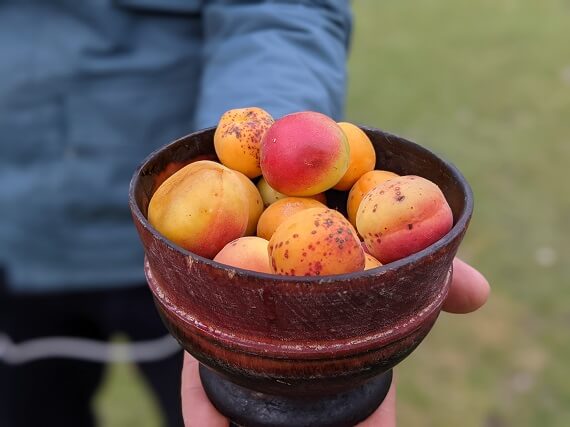
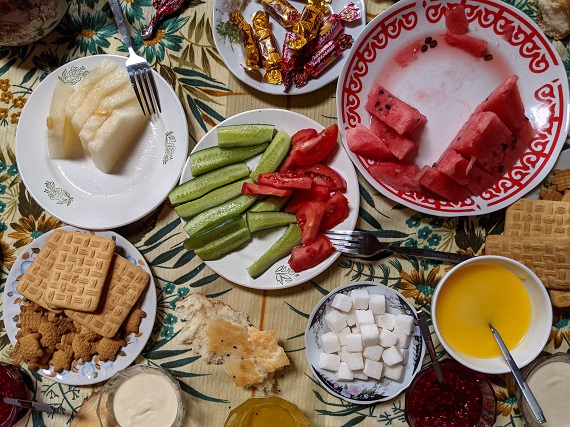


If this feast wasn’t already enough, the neighbour, who had noticed the unexpected guests, came over to offer the family the oromo she had no doubt spent all afternoon making, to share with us. Oromo is a very thin dough that is stuffed with onions, potatoes and fat before being rolled into a log, twisted into a swirl and then cooked with steam and oil. Imagine a Polish pierogi in another form. Despite the couple’s insistence, the neighbour wouldn’t even come in to have a cup of chai. She said hello from the door and seemed content to know the guests would try her dish.
Despite all the work that has to be done every day on the jailoo, this family stopped short when strangers passed by, to enthusiastically and generously welcome them into their homes.
Smiling from ear to ear, the wife peppered up with questions. Where were we from? Were we married? How long? She proudly introduced us to her three sons, particularly proud of her youngest one who had light-colored eyes like his father. We tried our best to say what little we could in Russian and Kyrgyz, with our guides filling in the rest, and our hosts teaching us some new words. The husband, quieter, smiled warmly, frequently offering to refill our cups of chai. The boys 9, 7, and 4, stood quietly and curiously in the doorway. We’d barely finished eating before we were being invited to stay for dinner, or even stay for the night, which we had to politely decline.

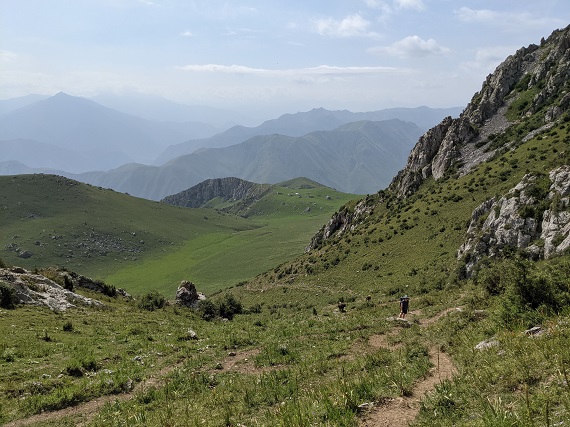
5. A Canyon
In Chinghis Aytmatov’s coming-of-age novella Jamila, known to all Kyrgyz, the title character breaks off her marriage and absconds into the mountains with her lover. They had met while carrying grain from their village down to the nearest train station during World War II. On the long return each day, Jamila listened to Daniyar sing, his voice echoing off the walls of a canyon. His voice caused her to fall in love, and they escaped together by heading upwards.Our final day also ended in a canyon. The Murdash River, teal-blue glacial runoff, cascaded through two narrowly-divided rock faces, each reaching hundreds of feet into the air. Walking through this canyon felt like sneaking through the hidden entrance to a caravan robber's lair in the middle ages. The canyon opens to a pinprick of a valley called Uch Chat, home to twenty families in the summer, surrounded by mountains on all sides, the sun collecting in the basin. The jailoo is not a secret, but it also isn't a postcard. Its beauty is not mainly in its scenery, its crisp and fresh air, its sense of childhood adventure: rather, its beauty is its inhabitants, whose smiles and curiosity and kindness make the jailoo a true summer home.
Text by Kevin and SC
Ak Tor Pass, Kyrgyzstan
August 8, 2021
Tweet
Practical Details - Kyrgyzstan
Hotels
In Bishkek, the Navas Hotel is right in the center, with beautiful traditional decorations. The suite [$75] is well worth it if the price is right.
Osh is tougher sledding. The TES Guesthouse has modern second-floor doubles [$37] with strong showers, and a garden courtyard that has long been home to long-distance cyclists, backpackers, and overlanders.
In the Alay mountains, we organized everything through CBT Osh, a community-based tour operator with branches through Kyrgyzstan. Our hike was a modified version of the Truly Nomadic Lands hike [$295 per person, all inclusive], which can also be done on horseback. It is possible to organize a similar trek independently, though there is little cell reception on the jailoos, so the hosts cannot be contacted directly. Our tour is cheaper on a per-person basis with a larger group.
Food
Freshly-baked flatbread ("non") and summer fruits including donut peaches and apricots, local honey, berry jam, and melon are all justly famous going back to the reports of Marco Polo. Vegetarians are easily catered for by CBT, though restaurants in Central Asia are very meat-centric.
Chicken Star, a Korean fusion restaurant, and Torre Burger, a chain with its own food truck, are both very good in Bishkek, and both with vegetarian options. Good coffee is difficult to come by throughout the country, though Sierra Coffee in Bishkek is the best. Cafe Brio and Dolce Vita in Osh have the best non-local food in Osh if you are ready for a change after your hike.
Transport
Kyrgyzstan is very mountainous. Traveling from Bishkek to Osh by shared taxi takes up to 14 hours on winding roads; a better alternative is to fly on local airlines Tez Jet or Avia [$40]. Tickets on both appear expensive in online searches, but can be purchased very cheaply in country at an aviakassa.